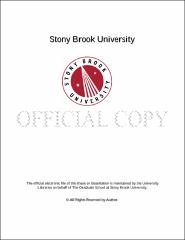| dc.identifier.uri | http://hdl.handle.net/11401/76152 | |
| dc.description.sponsorship | This work is sponsored by the Stony Brook University Graduate School in compliance with the requirements for completion of degree. | en_US |
| dc.format | Monograph | |
| dc.format.medium | Electronic Resource | en_US |
| dc.language.iso | en_US | |
| dc.publisher | The Graduate School, Stony Brook University: Stony Brook, NY. | |
| dc.type | Thesis | |
| dcterms.abstract | Although transmission electron microscopy (TEM) is extremely powerful at the characterization of materials on the nano- and atomic scales, the advantages introduce accompanying drawbacks. That is, high energy electrons offer the structural information while imparting radiation damage to the samples. Metal organic frameworks are a new class of materials that have potential applications in gas storage and catalysis. A direct imaging of their lattice structures is highly desired. However, these samples are extremely radiation sensitive. In order to characterize their structures, low-dose TEM need to be performed. To date, there is a lack of a systematic of radiation study of the radiation sensitive of MOFs. To fill this gap, in this thesis we performed a systematically study of the critical dose of a series of metal organic framework (MOF) samples in TEM. We characterized the critical dose for Cu, Ni, NiCu, NiCo, CoCu and NiCoCu MOFs samples using time lapsed electron diffraction measurement. We found that within our test range, the critical dose is independent of dose rate. We also found that the MOF the samples that contain nickel are more resistance to radiation damage. In contrast, the MOFs that contain copper are more radiation sensitive. For NiCo and CoCu MOFs, their critical dose are 999.18 (e^-/Ã…^2 ) and 28.41 (e^-/Ã…^2 ) respectively. By adding copper the NiCo MOF to form NiCuCo MOF, the critical dose is reduced from 999.18 (e^-/Ã…^2 ) to only 16.98 (e^-/Ã…^2 ), suggesting the copper can significantly affect the properties of the MOF structure. We also analyzed the diffraction pattern of MOFs attempting to build a correlation between the critical dose and maximal lattice spacing. However, we found that the maximum critical dose does not always track the maximal spacing. Through this research, we can calculate the suitable dose rate for either imaging or diffraction tomography measurement for these samples. | |
| dcterms.abstract | Although transmission electron microscopy (TEM) is extremely powerful at the characterization of materials on the nano- and atomic scales, the advantages introduce accompanying drawbacks. That is, high energy electrons offer the structural information while imparting radiation damage to the samples. Metal organic frameworks are a new class of materials that have potential applications in gas storage and catalysis. A direct imaging of their lattice structures is highly desired. However, these samples are extremely radiation sensitive. In order to characterize their structures, low-dose TEM need to be performed. To date, there is a lack of a systematic of radiation study of the radiation sensitive of MOFs. To fill this gap, in this thesis we performed a systematically study of the critical dose of a series of metal organic framework (MOF) samples in TEM. We characterized the critical dose for Cu, Ni, NiCu, NiCo, CoCu and NiCoCu MOFs samples using time lapsed electron diffraction measurement. We found that within our test range, the critical dose is independent of dose rate. We also found that the MOF the samples that contain nickel are more resistance to radiation damage. In contrast, the MOFs that contain copper are more radiation sensitive. For NiCo and CoCu MOFs, their critical dose are 999.18 (e^-/Å^2 ) and 28.41 (e^-/Å^2 ) respectively. By adding copper the NiCo MOF to form NiCuCo MOF, the critical dose is reduced from 999.18 (e^-/Å^2 ) to only 16.98 (e^-/Å^2 ), suggesting the copper can significantly affect the properties of the MOF structure. We also analyzed the diffraction pattern of MOFs attempting to build a correlation between the critical dose and maximal lattice spacing. However, we found that the maximum critical dose does not always track the maximal spacing. Through this research, we can calculate the suitable dose rate for either imaging or diffraction tomography measurement for these samples. | |
| dcterms.available | 2017-09-20T16:42:30Z | |
| dcterms.contributor | Venkatesh, T. | en_US |
| dcterms.contributor | Xin, Houlin | en_US |
| dcterms.contributor | Sokolov, Jon. | en_US |
| dcterms.creator | Pan, Wei-Yu | |
| dcterms.dateAccepted | 2017-09-20T16:42:30Z | |
| dcterms.dateSubmitted | 2017-09-20T16:42:30Z | |
| dcterms.description | Department of Materials Science and Engineering | en_US |
| dcterms.extent | 49 pg. | en_US |
| dcterms.format | Application/PDF | en_US |
| dcterms.format | Monograph | |
| dcterms.identifier | http://hdl.handle.net/11401/76152 | |
| dcterms.issued | 2016-12-01 | |
| dcterms.language | en_US | |
| dcterms.provenance | Made available in DSpace on 2017-09-20T16:42:30Z (GMT). No. of bitstreams: 1
Pan_grad.sunysb_0771M_12822.pdf: 2450314 bytes, checksum: 800fb3c1654e639b61b23ee035d989e6 (MD5)
Previous issue date: 1 | en |
| dcterms.publisher | The Graduate School, Stony Brook University: Stony Brook, NY. | |
| dcterms.subject | Materials Science | |
| dcterms.subject | dose test, elastic and inelastic scattering, electron diffraction, Metal Organic Frameworks, radiation damage, TEM | |
| dcterms.title | Interrogation of possible imaging conditions for radiation sensitive metal organic frameworks in transmission electron microscopes | |
| dcterms.type | Thesis | |

